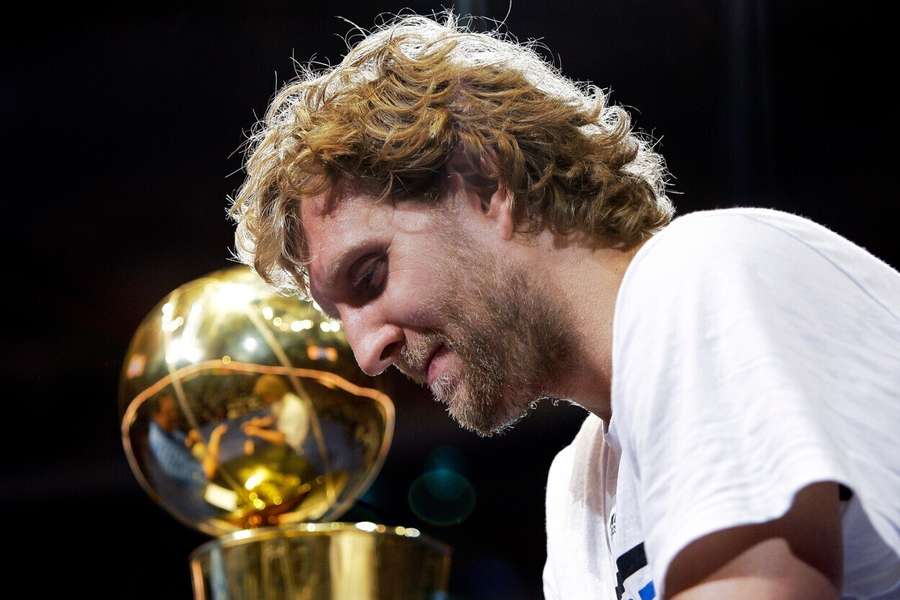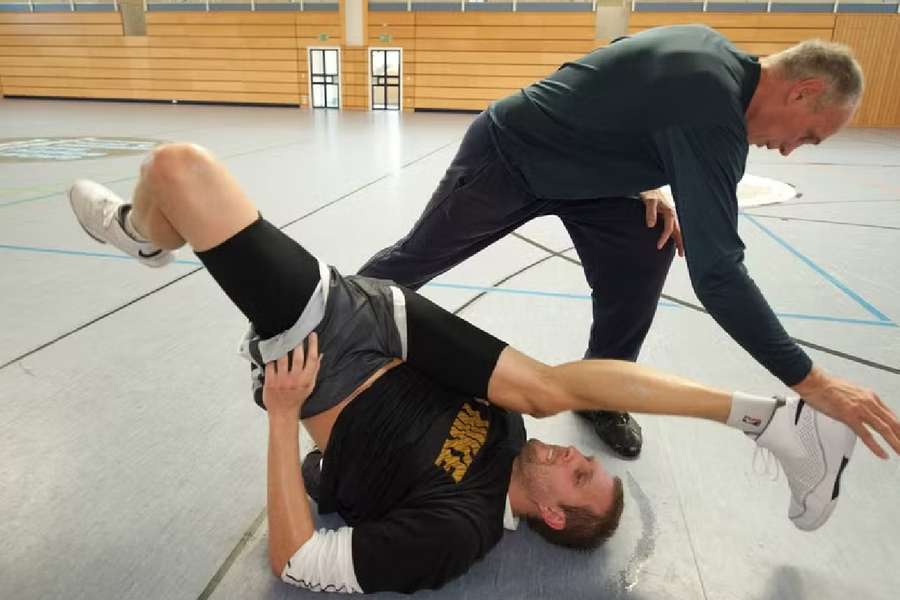From Heidingsfeld to the Hall of Fame: Dirk Nowitzki's quiet superstar career

The first steps
Würzburg-Heidingsfeld is a middle-class residential area - characterised by detached and semi-detached houses. There is a bus stop, an Edeka shop, fields and hills. Young Dirk Nowitzki grew up in Unterer Katzenbergweg with his father Jörg, mother Helga and sister Silke. A sports-mad family. At six, Dirk tried handball, emulating his father. When his parents tried tennis in their free time, Dirk also took up the racquet enthusiastically. He didn't get into basketball until he was 13, when he joined his school team.
His parents actually set up the basket for his sister, who was already active in the club. But Dirk, at this time over two metres tall already, spent hours flying the orange rubber ball through the air and told his father that he wanted to change sports. In his room, a poster of Scottie Pippen was placed above his bed and one of Charles Barkley on his wardrobe.
Mantor Geschwindner
In 1993, Nowitzki met his mentor Holger Geschwindner at a regional league match in Schweinfurt. Nowitzki was 16 at the time. Geschwindner, a former national and Bundesliga player, developed an innovative, one could even say crazy, training concept for his protégé. He combined elements from mathematics, psychology and physics. For Geschwindner, basketball is like music: "The player must be able to control his dance steps. Well danced is well played," he writes in his book . The body is an instrument, the basketball team a jazz band.
A spartan gymnasium in Rattelsdorf became their rehearsal room. They got the key at the bakery on the market square, they trained between school classes. Here Nowitzki jumped across the field like a rabbit for years - ten jumps for 28 metres. He ran through the hall on his hands, wore a lead waistcoat when shooting. According to Geschwindner's calculations, he practiced the perfect trajectory of the ball and body position when shooting. Geschwindner, however, gave his talented pupil a lot of freedom: "Early on, the boy organised his own fitness training. Dirk was ambitious."

Geschwindner's training camps are also legendary. He invited his players to go rowing at Lake Starnberg, and in the morning "jazz gymnastics units" were on the programme. Only then they were allowed to go to the basketball court. Geschwindner kept offering new ideas without limiting Nowitzki or giving him the solution.
Between betrayal and promise
On 29 March 1998, Geschwindner and Nowitzki were on a plane bound for San Antonio. Nobody in Würzburg knew about theirplan. DJK Würzburg's decisive promotion match to the first Bundesliga was set to take place on the weekend. But Nowitzki was not in Würzburg, but at the Nike Hoop Summit, the meeting of the best American and international talents. Even if the outrage in his home town was initially huge, this was the breakthrough for Nowitzki. He scored 33 points, grabbed 14 rebounds, converted 19 of his 23 free throws and wass already being compared to the legend Larry Bird. Würzburg won the promotion duel even without its best player.
Nowitzki's name was immediately boldly written in the notebooks of NBA scouts. On 24 June 1998, the Milwaukee Bucks drafted him ninth overall, but immediately traded him to the Dallas Mavericks for Robert Traylor. Nowitzki was only the fourth German after Detlef Schrempf, Uwe Blab and Christian Welp to make it to the best basketball league in the world. At his presentation in Dallas, he stood shyly on the podium next to a blond Steve Nash, who was also new to Texas. A strong friendship developed between the two.
In Germany, not everyone believed he would make a quick breakthrough. Geschwindner quotes the then-Bundesliga coach and former national coach Svetislav Pesic in his book: "He shouldn't have switched to the NBA. There, the coaches expect ready-made players, but Dirk is not yet mature. I doubt the Dallas Mavericks will have the patience to mould Nowitzki's talent into an NBA player,"
Nowitzki's first NBA season seemed to prove the critics right. The season did not begin until the beginning of 1999 after a strike. The rookie was left with only 47 season games, 8.2 points and a three-point shot percentage of 20 percent. Nowitzki was far away from his family for the first time. But in Steve Nash he had found a companion and in Don Nelson a coach who believed in him.
"The German Wunderkind"
Nowitzki was already maturing into a star in his second season. He turned the grey mouse Dallas into a playoff team. Then, in 2002, the first All-Star Game in Philadelphia comes. The 2.13-metre forward played alongside Kobe Bryant, Shaquille O'Neal or Tim Duncan - thirteen more nominations for selection were to follow. In 2006 and 2007 Nowitzki experienced the greatest lows of his NBA career. After leading 2-0, his Mavs lost 4-2 to the Miami Heat in the Finals. A year later, they were eliminated as the top seed in the first round against the Golden State Warriors and their old coach Don Nelson. Shortly after this bitter defeat, Nowitzki was named MVP, the best player of the regular season. That's how close defeats and victories are.
Despite sometimes playing 100 NBA games per season, Nowitzki put on the jersey of the German national team summer after summer. In 2002, he and his team won the bronze medal at the World Championships in Indianapolis, followed by silver at the European Championships in Serbia and Montenegro in 2005. In 2008, he fulfilled the dream of the Olympic Games for himself and his teammates. With the Olympic rings shaved into his hair, he carried the German flag into the Bird's Nest in Beijing. His DBB career only ended in 2015 at the European Championships in his home country. The number 14, which he wore in the national team, made one last appearance at the Mercedes-Benz Arena in Berlin and bowed to the audience after the final siren.
Champion and mentor
Dirk Nowitzki made himself immortal in 2011. He was almost 33 and his knees were beginning to hurt. Many already saw him as an above-average player, but he had never been able to win an NBA championship. The bitter playoff defeats in 2006 and 2007 contributed to this reputation. Five years after the trauma against Miami, the Heat were again their opponents in the finals. On paper, the superteam from Florida with LeBron James, Dwyane Wade and Chris Bosh was the favourite. But this time Nowitzki turned the tables and carried his Mavs to the first championship in club history. Nowitzki was Finals MVP. Hundreds of thousands lined the streets of Dallas for the victory parade. Nowitzki belted out "We are the Champions" to the masses. He finally arrived on the basketball Olympus, and a street is even named after him in Dallas.
In Würzburg, too, countless fans welcomed him, just like at his Mavericks' guest game against ALBA Berlin. For only a few minutes, Germany's biggest sports star limped across the field visibly ailing, but that did nothing to dampen his performance. Ten more years in the North American professional league followed. Slowly, the enormous strain takes its toll. Nowitzki went from being a top performer to mentor to the new Dallas star: Luka Doncic.
Nowitzki's 21st season was his last. Never before had a player in the NBA played for a single team for so long. In his book "The Great Nowitzki", Thomas Pletzinger describes how the player from Würzburg imagined his career ending: "Quietly and unnoticed. Just play and then say: that's it," But America is the opposite of that. Heroes are celebrated there, even if, like Nowitzki, they seem a little stiff at the end of their careers.
The last season became a farewell tour. Career highlights flickered across the video screens, whether in Phoenix, New York or Toronto. In his last home game, on 9 April 2019, Nowitzki got to score 30 points one more time. His family and his mentor Holger Geschwindner were in the stands. The idols of his childhood stood in the centre of the American Airlines Center. Charles Barkley and Scottie Pippen came, years after Nowitzki only saw them on posters in his Heidingsfeld nursery. A circle closed.
